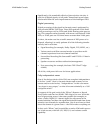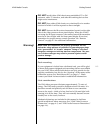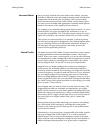
1-10
Getting Started Mark Levinson
The analog backplane, as discussed, rivals the finest matrix switch-
ers used in the professional video world.
In addition, the Nº40 has a standard definition digital video back-
plane, and a dedicated high definition digital video backplane. The
standard definition digital video backplane is used for routing
transcoded video signals within the Nº40 (more in a moment), and
for our digital graphic user interface. In all, there are over 2000
“nets” (connections) in the video backplanes to ensure that you can
get the signal you want to where you want it.
Transcoding
You may remember that a goal of the Nº40 was to operate with full
independence among its five zones. In the realm of video, this
requires a “Universal Translator” function that can convert between
the various video signal formats likely to be encountered, within a
given broadcast standard.
The Nº40 video processor will receive standard, interlaced compos-
ite, S-video, and component signals and transcode them to provide
all of those formats simultaneously on all zones. It will convert
signals “up” or “down” as needed to ensure that all outputs are
active, all the time, regardless of input signal. (Note, however, that
the Nº40 does not change frame rates or broadcast standards. For
example, we do not convert from 60 fps NTSC to 50 fps PAL or vice
versa.)
Also, progressive input signals cannot be routed to RZones, since
there is no definition for a progressive composite or S-video signal
format exists. If you have a progressive source, we suggest connect-
ing both its progressive output (for use in the main zone, without
any further signal processing) and its S-video or composite output
(for use in remote or record zones). Set up two inputs, one for each
type of video, naming them something like DVD-p and DVD-i. Use
the interlaced signal in the RZones.
Thus you can make whatever connection is best for your subse-
quent video processing or display device, and not concern yourself
about switching between formats as you select sources – the Nº40
takes care of all that for you.
In the remote zones, the Nº40 also provides both composite and S-
video connections that are always active, even when the selected
source is a component signal.


















